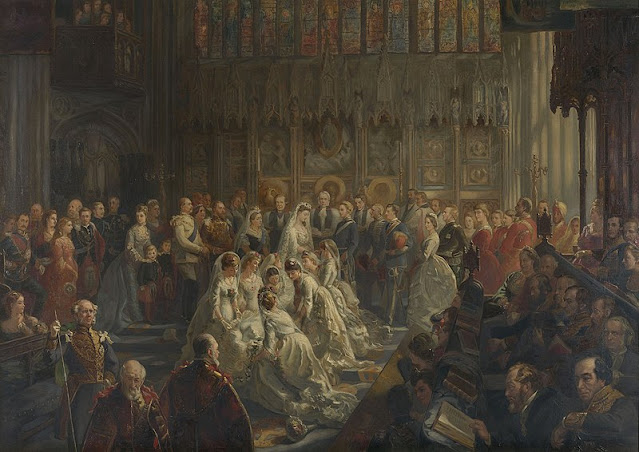 |
| "The Marriage of Princess Louise, 21 March 1871" by Sydney Prior Hall |
On March 21, 1871, Princess Louise of the United Kingdom was married to John Campbell, Marquess of Lorne, later Governor-General of Canada and 9th Duke of Argyll. Princess Louise was the fourth daughter and sixth child of Queen Victoria. Lord Lorne, meanwhile, was the eldest son and heir of George Campbell, 8th Duke of Argyll, and the former Lady Elizabeth Sutherland-Leveson-Gower, daughter of the 2nd Duke of Sutherland.
Princess Louise was considered as Queen Victoria's most beautiful daughter and she was sought by European princes for marriage. However, the princess shunned the idea of marrying a royal. When it was announced that she wished to marry John Campbell, Marquess of Lorne and heir to the Dukedom of Argyll, some members of the British Royal Family were outraged. The idea of marrying someone lower than her station (even if Lorne was a member of the upper crust and a scion of one of Scotland's richest landowning clans) was unheard of in those days. However, Queen Victoria saw the wisdom in her daughter's decision and she believed Louise's marriage to Lord Lorne would inject "new blood" into the family. After all, Louise's marriage to the Scottish heir would mean her daughter would not have to leave England; keeping her daughters close to her was favored by the queen.
In a letter to Queen Augusta of Prussia, she said that poor German princelings were highly unpopular in Great Britain. Lord Lorne, meanwhile, was the heir not just to his father's titles, but also to his vast estates, making him "really no lower in rank than minor German Royalty." The Britons, too, rejoiced in the idea that one of their princesses would marry a local.
The wedding was held at St. George’s Chapel on Windsor Castle. A correspondent for the New York Times writes that "little excitement" was observed in London. In fact, "much dissatisfaction prevailed because the wedding did not take place at Westminster Abbey or St. Paul's." Nevertheless, "bells chimed in the afternoon" and tradesmen displayed “illumination” that evening.
On the other hand, the town of Windsor was filled with life. Thousands of people crowded the Castle Green and Etonians flocked the Castle Hill. The police and soldiers had to make sure that the streets remained open for the invited guests, who were traveling on royal carriages from the train station to the castle.
The interior of the chapel looked "magnificent, with knightly banners, gorgeous uniforms, rich robs, diamonds sparkling, and the sunshine streaming over all." Among the invited guests were members of European royal families, the "very cream of the English society," government officials, and diplomatic corps.
The Duke of Argyll, the groom's father, wore full Highlands attire, while the duchess was "robed in cloth of silver." Princess Alexandra dazzled "in a blue satin robe with a train of blue velvet" as she led her children who were wearing "Scotch costume." Princess Christian arrived in "pink satin, trimmed with white lace," while an Indian princess was "blazing with scarlet gold." Queen Victoria, who gave the bride away, entered the church "robed in black satin, very low in the neck," while wearing a veil and "a coronet of diamonds." The groom, Lord Lorne, entered as the choir sung an anthem. He was escorted by his groomsmen, Earl Percy and Lord Leveson Gower.
Princess Louise marched wearing "a dress in white satin, with white velvet train, a Honiton lace veil and wreath of orange flowers," which was held by eight bridesmaids, who were daughters of either a duke or an earl, and were "dressed in silks, with necklaces and wreathes of roses."
The wedding ceremony was officiated by the Bishop of London, assisted by the bishops of Winchester, Worcester, and Oxford. After vows were exchanged and the couple proclaimed husband and wife, Queen Victoria took her daughter in her arms and "gave her a hearty kiss." The groom then knelt and kissed his mother-in-law's hand. The guests began approaching to congratulate the new couple. As they walked out towards the from chapel door, the people cheered and waved. The royals and their guests proceeded to the castle for the wedding breakfast where "two immense wedding cakes were served." No speech was made but "there was great gaiety." Princess Louise retired to change her wedding dress and she reappeared in a "charming traveling costume of Campbell plaid."
After the wedding breakfast, the couple took a carriage and went to Claremont House in Surrey, where they spent their honeymoon. The route where the wedding party passed wad installed with triumphal arches and people lined the road to cheer Princess Louise and Lord Lorne.

.png)





0 Comments